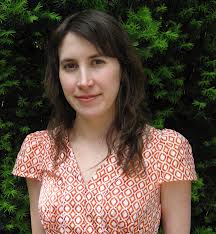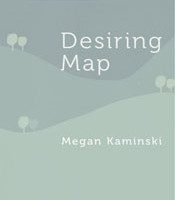The most compelling feature of the set of Encyclopedia Britannica volumes—purchased by my parents from a door-to-door salesman in the 1970s—was a series of illustrations diagramming the intricacies of human anatomy with celluloid overlays. Cellophane circulatory system mapped onto nervous system mapped onto digestive system mapped onto reproductive system mapped onto musculature mapped onto skeletal scaffolding. Reading the poems in Megan Kaminski’s Desiring Map, I’m transported back to the green shag carpet of my grade-school years, crackling through the visceral layers—though Desiring Map functions more like a multimodal atlas than an encyclopedia: “atlas of trees,” “atlas of memory and sky” As eventually happened with the much-thumbed human anatomy illustrations, maps in Kaminski’s atlas do not lie flat, there is a “[c]rease in the field of morning” and “snags pepper the estuarine marsh” (“Across Soft Ruins”). The collection’s textured poetic terrains are not sequentially nor linearly plotted out, but overlaid and overlapping in reversible sheets—east coast mapped onto wetland mapped onto ocean mapped onto prairie mapped onto west coast—as in this excerpt from “Favored Daughter” where sea is superimposed on an unbroken stretch of prairie:
no way to define the port to which
we might sail if sailing were
an option only fields as far as the gaze
takes our abeyance of scale
Or, perhaps, the visual surveillance of fields written here gets mapped back over a memory of sea. Perhaps memories (and their corollary desires) provide the compressing forces for such geographical layering.
*
Memory, landscape, language: these three recurring points sown throughout Desiring Map cast a triangle of correlation into which explorations of the pastoral squarely fall. Phrases from the opening sequence of “Across Soft Ruins” (“Summer starred night mints sleep new again” and “out past the screen door/shell enameled eyes and/cardamom seeds/expand our path towards hills”) carry echoes of Milton’s famous pastoral elegy, Lycidas. Here’s a brief excerpt:
Ye valleys low where the milde whispers use,
Of shades and wanton winds, and gushing brooks,
On whose fresh lap the swart Star sparely looks,
Throw hither all your quaint enameld eyes,
That on the green terf suck the honied showres,
And purple all the ground with vernal flowres (136-141).
Throughout Desiring Map, too, we find a cataloging of flora—roses that “punctuate hillsides,” “snips of nodding aster and cow lily,” “remembrance of purple flowers,” “silky prairie clover”—though, likely as not, Kaminski’s flowers are spilling out of dixie cups. We find a monitoring of herds: cows “assessing their own solemn limits,” sheep “stamping patterns into the earth” (“Across Soft Ruins”). We even find pockets of idyllic sanctuary—Kaminski is a deft spinner of rich yet economical imagery—but we will not be offered any facile escape from fractures in a contemporary rural landscape co-opted by corporate farms, packing plants, chemical refineries, and “manmade lakes.”
Were it ever possible to map easy admonitory allegories of idealized rural landscape onto critiques of corrupt urban space (which seems doubtful), the stratification and commodification of labor in an era of late capitalism makes such a strategy particularly unpromising. Although the pastoral has been enmeshed with depictions of labor from its very roots (consider Hesiod’s Works and Days), current global economic conditions demand reconfiguration of such a relationship. This Kaminski seems acutely aware of, laying open the pastoral tradition with similar (at least to my mind) discursive and dialectical methods with which a contemporary Marxist (such as Fredric Jameson) might interrogate aesthetics/cultural production in the era of late capitalism—cultural production as the genesis of both contemporary conditions of “realism” and attempts to disguise and divert from the contradictions embedded in these conditions. The third section of Desiring Map, “Carry Catastrophe,” for example, considers the reality of the current economic crisis, with its often still-gratifying diversions, using the lens of catastrophe theory.
*
In the 20+ years since Jameson published Postmodernism: Or, the Cultural Logic of Late Capitalism, events such as the Occupy movements and the Arab Spring, my most trusted Marxist friend assures me, have shifted focus away from the use of Jameson’s model of “cognitive mapping” as a method of cultural engagement. As a method for the individual psyche to engage with an increasingly unstable environment, however—particularly when combined with contemporary theories in neuroscience (more on this later)—cognitive mapping remains a valuable tool. Desiring Map seems to cue readers in this direction as well, employing a speaker who “makes flight routes in [her] mind,” confiding that “crushed shells speak of lost cities/at least she likes to imagine it that way/tracing the spine of burnt hills in her brain’s mapping.”
In sketching out his project for a spatial analysis of culture, Jameson draws on, among other sources, Kevin Lynch’s The Image of the City. In this work, Lynch uses interviews and map-sketches to speculate that the degree of isolation experienced by a subject is proportional to the degree his or her city is unmappable. Parts of Boston, with their easily identifiable historical landmarks (or better “imageability”), for example, may be less alienating than parts of Jersey City, which lack clearly distinguishable features. While Lynch’s study, and Jameson’s incorporation of it, lay solid parameters for a system of cognitive mapping, the poems in Desiring Map push me to widen the scope of such a system, to grapple with additional questions: What if a mapping subject does not remain a stable point in its present-tense city? What happens to the mental map(s) of a subject who is constantly city-hopping, exchanging city for city or city for prairie and plains? How do these cognitive maps become complicated by the entrances and exits of other bodies to/from a subject’s cognitive territory? By litterings from other remembered cities?
 Desiring Map is not merely a poetic project that maps, but one that constantly repositions, re-imagines, the boundaries of mapping. Is mapping inherently a project of domination or can it be used as a tool for liberation? The answer may depend on whether one classifies mapping as a tool of science or a tool for communication, to dictate to or direct an audience—in other words, if one applies to cartography the internalized criticism: “your discipline is lovely but ours is not” (“Across Soft Ruins”). A long history of counter-mapping exists—one striking example features biographical maps published in the 1976 Inuit Land Use and Occupancy Project, maps that directly influenced the creation of the Territory of Nunavut. Yes, maps can be used as tools of domination, but they can also be forms of protest and reclamation: “let’s track green dots on trees/our own operation of marking up boundaries” (“Across Soft Ruins”). And, yes, language can be an effective means to erase or restructure officially sanctioned boundaries: “sentences accumulate spread across county lines/soak up lake-water” (“The Prairie Opens Wide”).
Desiring Map is not merely a poetic project that maps, but one that constantly repositions, re-imagines, the boundaries of mapping. Is mapping inherently a project of domination or can it be used as a tool for liberation? The answer may depend on whether one classifies mapping as a tool of science or a tool for communication, to dictate to or direct an audience—in other words, if one applies to cartography the internalized criticism: “your discipline is lovely but ours is not” (“Across Soft Ruins”). A long history of counter-mapping exists—one striking example features biographical maps published in the 1976 Inuit Land Use and Occupancy Project, maps that directly influenced the creation of the Territory of Nunavut. Yes, maps can be used as tools of domination, but they can also be forms of protest and reclamation: “let’s track green dots on trees/our own operation of marking up boundaries” (“Across Soft Ruins”). And, yes, language can be an effective means to erase or restructure officially sanctioned boundaries: “sentences accumulate spread across county lines/soak up lake-water” (“The Prairie Opens Wide”).
*
The hippocampus, the site of episodic (biographical) memory, is also the site of spatial learning. Though it is not yet clear how, brain imaging shows that the processes are related. Data from inter-species, lesion, and imaging studies, however, lend credence to “parallel map theory,” a refinement of neurological models of cognitive mapping. The parallel map theory postulates that two parallel mapping processes, located in two separate sub-regions of the hippocampus, rely on different methods of representing space (“bearing” map and “sketch” map) that are then combined to generate an integrated spatial map. The bearing map orients to vector stimuli (size, color, temperature, altitude, chemical concentration), while the sketch map navigates a distribution of objects.
What neuroscience is beginning to tease out, Kaminski’s poems seem to grasp intuitively: a subject’s personal navigation of space requires integration of both bodily cues and retrieval of landmarks incorporated into long-term memory, that “the configured arrangements of interiors/occupy our time” (“Favored Daughter”). Further, if we unmoor parallel map theory from its local neurological riggings, isn’t it possible the brain might organize landscape memory in reverse directions as well? So that the gradient cues of a new environment—new angles of sun, new temperatures, new environmental chemistries—get mapped back upon skeletal sketch maps cataloging old cities’ landmarks? (“upriver she hears whispers from the Pacific/belated by five years”). In this recursive, reversible mapping, might we find blueprints for an individualized atlas of “desiring maps?”
*
Here I am…
a poem in “Carry Catastrophe” proclaims:
carving rivers,
silken space
partitioning
lake to
tree…
And here I am, back in the green field of shag, sifting through the cellophane layers. I peel one back, then another, searching for the bare bones, the essential skeleton, but the last leaf is only scaffolding onto which multiple organ maps may be overlain. This overlap is the essence. Here is the brain: skimming its grubby, impulsive fingers through the layers, collapsing and excavating.




